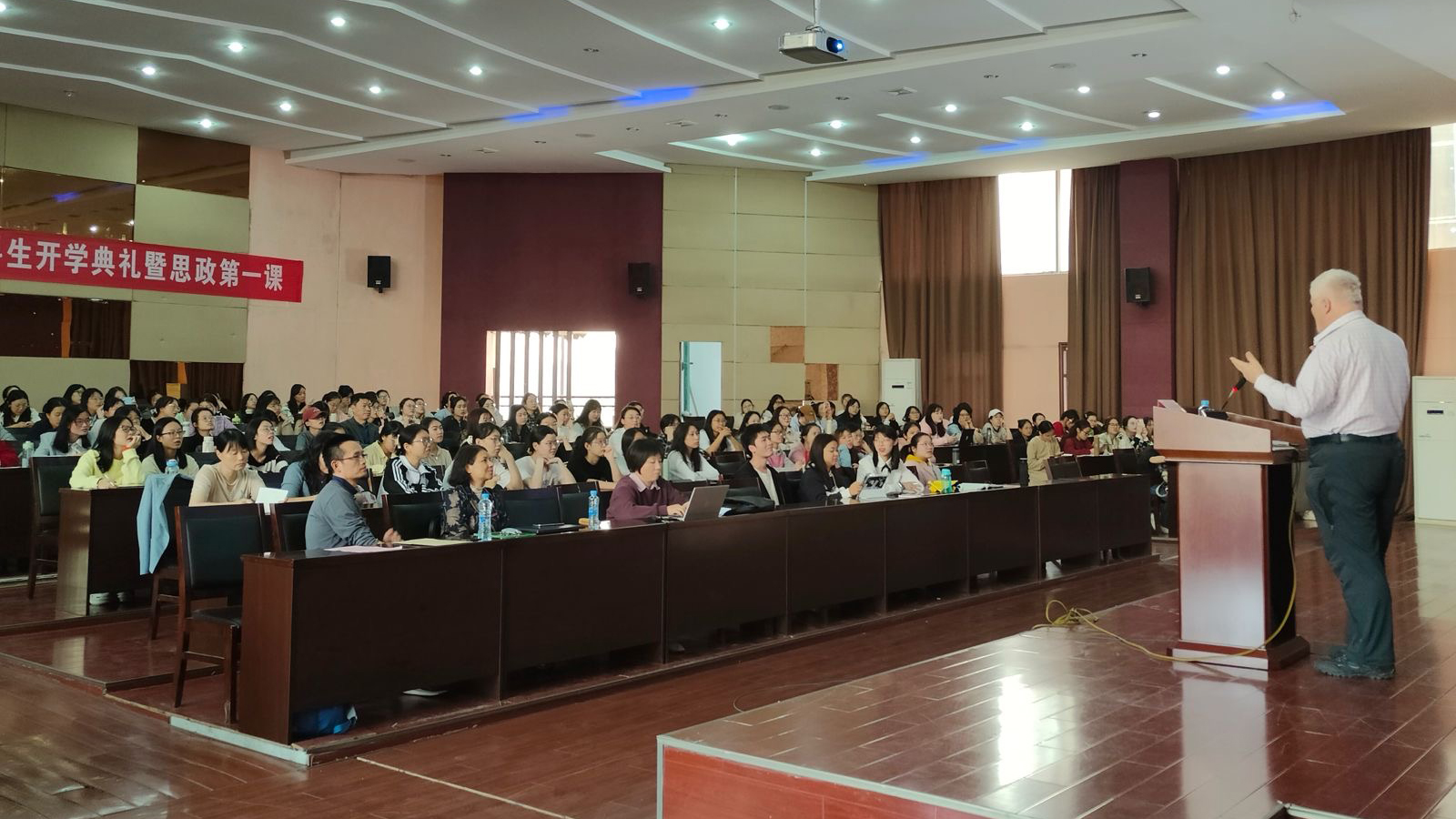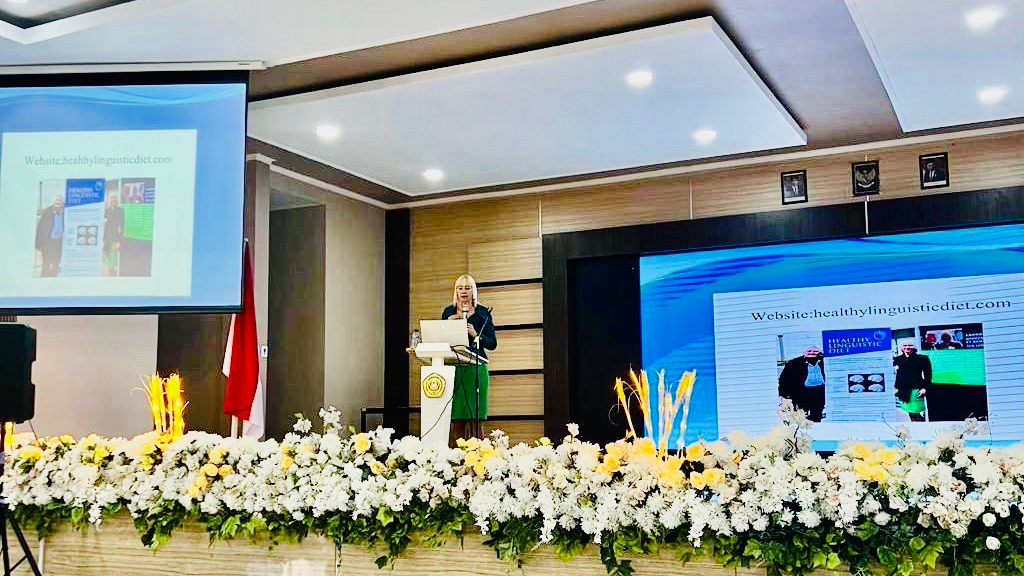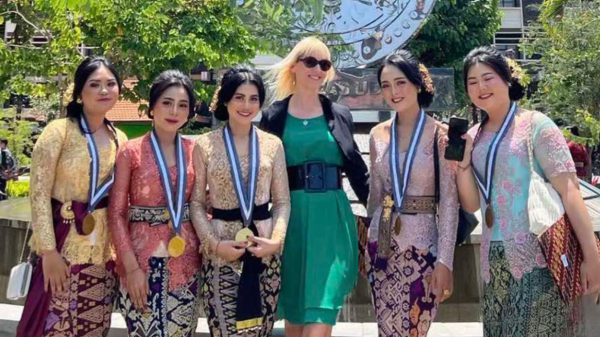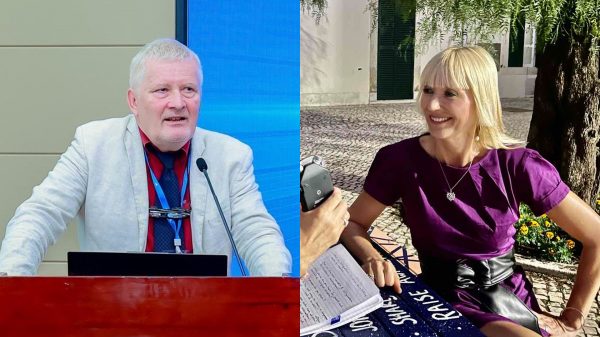
18.12.23
When concepts migrate: Complexities of migrating Healthy Linguistic Diet
By Dina Mehmedbegovic-Smith and Thomas H Bak
Image above left: Thomas giving a keynote at the first International Conference on Language Development and Assessment (ICLDA 2023), October, 2023 at Zhejiang University, Hangzhou, China
Image above right: Dina with a representative of parents association at St. Julian’s School, Lisbon, Portugal recording a podcast on HLD for parents
Migration of people brings with it migration of languages and cultures resulting in multilingual and multicultural communities and hyperdiverse global cities such as London, New York, Toronto, Dubai, Singapore, Hong Kong, Melbourne, to name a few. However, reactions to such diversity can vary. It can be perceived as a positive development, invigorating the economy and enriching inhabitants’ life by allowing them to experience different cultures without the need to travel far. But it can also cause anxiety about one’s own culture and language being endangered. And such anxiety can easily lead to hostility against everything perceived as foreign, including the languages. This leaves immigrants with the unenviable choice of either denying their own language and culture in order to adapt, or to withdraw into their original community, cutting themselves off from their host country. Such a withdrawal can increase the hostility of the host society, resulting in a vicious circle of mutual rejection.It is against this background that we , the authors of this blog, both migrants ourselves, with history of multilingualism as well as of language loss in our own families, developed the concept of Healthy Linguistic Diet (HLD). Based on the conviction that all languages have a value worth protecting, HLD advocates a positive attitude to the preservation of migrant languages, while also encouraging learning new ones. Indeed, it considers the preservation of home languages and learning the language of the new countries as two sides of the same coin, reinforcing rather than opposing each other. It provides a model to encourage recent and settled migrants to maintain and further develop their home languages, but also to inspire young people and adults to invest in learning foreign languages in order to enjoy life-long benefits of bilingualism/multilingualism.
One of the important elements of our vision is to reach out to all stakeholders: children, young people, parents, grandparents, educators, lead professionals, academics, researchers, policymakers, politicians, diplomats. We have personally given lectures on HLD for a range of audiences and stakeholders in 20 countries: Australia, Austria, Belgium, Bosnia & Herzegovina, Brazil, China, Croatia, Denmark, Indonesia, Italy, Finland, Hong Kong, Poland, Portugal, Singapore, Spain, Sweden, UAE, UK, USA.
HLD has been used in online EU Education Gateway professional development courses for 80,000 educators across EU countries and included in the EU Commission guidance for member states in the latest report on language learning: Languages for All. In Italy it was rolled out in schools with great success as an innovative initiative funded by INDIRE (Italian National Institute for Documentation, Innovation and Research in Education). The most recent development is a partnership being developed with the key institutions in Indonesia, the Ministry of Education and several universities, where HLD was introduced this autumn in a series of public lectures at two national conferences and nine universities.
Throughout this global dissemination of our research and vision we have been looking to translate HLD in many different languages used by our audiences, readers and users of our website and publications. On the home page of HLD we have an interactive banner running across the screen with HLD written in a wide range of languages and scripts. Our blog pages have blogs written in, apart from English: Arabic, Croatian, Polish, Italian, Malay and we are always looking to make our website more diverse.
While focusing on widening our global outreach and making HLD model more accessible for our audiences, we have encountered complexities of not only translating our concept, but in fact finding an appropriate equivalent to the term “Healthy Linguistic Diet” in a range of languages. As many of our colleagues and readers will be aware – simply translating a concept often does not work.

Image above: Thomas giving a lecture in Nanchang, Jiangxi province, China

Image above: Dina giving a public lecture attended by the audience of 400 students and academics at the Indonesian National Institute of Education, Garut, West Java, Indonesia
When concepts migrate between languages and cultures adjustments need to be made in order for an appropriate equivalent to the original to be formulated.
When one of us (THB) was recently giving a talk in German, the question arose how to translate “healthy linguistic diet” into that language. German language has a word “Diät”, which sounds deceptively close to the English “diet”, but the context of use is not the same. While in English “diet” is often associated with health (e.g. “Mediterranean diet”, “healthy diet” etc), in German the word “Diät” can invoke associations of illness, e.g. stomach or liver diet, or at least of suffering, e.g. a strict diet necessary to lose weight (a similar situation can be seen in many other European languages, from Spanish to Polish). An alternative term, often used in the context of health, is “Ernährung”, e.g. “gesunde Ernährung”, “mediterrane Ernährung” etc. However, when the German title of THB’s talk, “Gesunde sprachliche Ernährung” was automatically backtranslated into English on social media, it produced “Healthy Linguistic Nutrition”. Nutrition is not a bad translation, but again, its associations are not identical to “Ernährung”. Accordingly, “gesunde Ernährung” would be better translated as “healthy diet” than “healthy nutrition”.
The lesson from this experience reinforces the leading idea of HLD: every language is a world in itself, rich and precious, with its own associations and connotations. Accordingly, we have chosen not the closest-sounding word (“Diät”), but one which, in our view, corresponded best to the spirit of our concept (“Ernährung”). Such adjustments often require wider discussion and consideration of the ways in which seemingly identical terms have taken on different meanings, even in languages which are close, genetically as well as culturally. We do not consider it a nuisance, a necessary evil of language differences. Every new association, every new shade of meaning is an invitation to open our minds, to question automatic monolingual assumptions, to see things from a new, different perspective. And this could lead to a better understanding. Thus, translating the concept of Healthy Linguistic Diet is already an exercise in it.
We hope that this blog dedicated to the UN’s International day of migrants will spark new interests for our readers and colleagues in exploring and understanding the way migration impacts on one’s work and environment.

